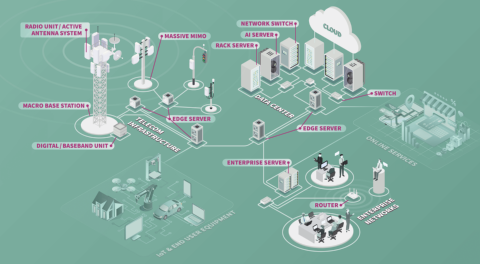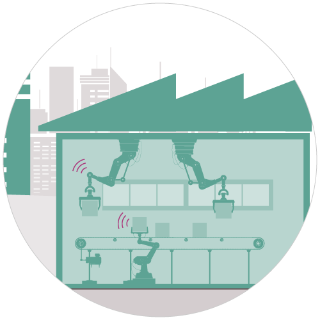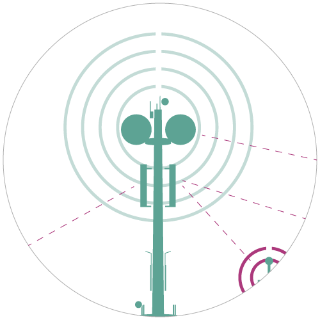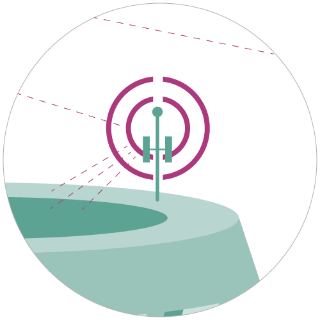
Reliable, secured and energy-efficient
Reliable, secured and energy-efficient
Cutting-edge semiconductors for data infrastructure and communication infrastructure
As the number of IoT devices and applications increases, so too does the volume of data traffic. Experts from IDC predict there will be 55.7 billion connected smart devices by 2025, generating almost 80 zettabytes of data. In bytes that is the equivalent of an 8 with 22 zeros!
We live in a hyperconnected world. More smart devices are connecting to the Internet every day, the IoT is growing and growing, new applications are springing up, and more and more data is being generated and needs to be processed. To make it all work, these vast amounts of data need to be transmitted, stored and processed securely and reliably, and without consuming huge amounts of energy.
What is data infrastructure and communication infrastructure?
Basically, it's about technologies, products and network connections that enable the storage of large amounts of data, as well as its processing and transmission over large distances - and all of this in real time. Networks, data centers, servers and IT infrastructure function as the brain and backbone of any IoT system. Though invisible to the naked eye, they have the power to connect devices, equipment and, in some instances, entire factories.

Major trends in the communications industry are opening up a host of new opportunities for consumers, businesses and communities worldwide. However, this ever-increasing demand for data requires flawless connectivity, higher performance, and wide-area coverage and therefore brings complex requirements for modern data and communications infrastructures: not only do they need to provide the computing power and storage capacity required for the Internet of Things, but they must also be efficient, robust and reliable, and offer high speed as well as maximum security for the data processed and stored in them.
Over the decades, Infineon has developed unparalleled expertise in the field of telecommunications, ranging from network to airborne communications and supported by an extensive portfolio of high-quality semiconductor solutions. With our portfolio of high-quality semiconductor solutions, our reference designs and our expert advice, we at Infineon can quickly get your project on track for success.
High-speed device connections
The super-fast 5G mobile-communications standard is the second cornerstone of the IoT. Seamless data transfer in real time is a basic prerequisite for “smart” applications. End-to-end 5G networks are instrumental in ensuring an unbroken connection of people, companies, machines, and automated processes in the IoT. With the technologies used here (such as data transfer in the millimeter wave range, small-cell networks, massive MIMO, and beamforming), 5G offers transmission rates 100 times faster than LTE and data rates of up to 10 gigabits per second. This opens up applications like telemedicine, in which a doctor can even perform surgery over the internet.
At the same time, the new 5G network enables wider bandwidths, meaning that many users can be served simultaneously while also receiving better quality. As such, 5G’s operation is much more stable and reliable. In a smart city, for example, 5G can provide motorists with congestion and accident warnings, as well as information on where to find a free parking space. Vehicles can communicate with one another or with the infrastructure, with fast and reliable data transfer acting as a driver for highly automated motoring. Industry 4.0 is yet another important 5G application. With its interlinked value creation and supply chains, wide-ranging sensor monitoring of production systems and interacting robots, this fourth industrial revolution is reliant on effective communication. However, expanding 5G communication infrastructure’s coverage is necessary for its potential to be exploited to the fullest.
On this website, you will soon discover how Infineon’s all-in-one product portfolio enables you to realize innovative technology solutions for communication and data centers.
We make IoT work!









